






Learn wow to use the subjective power of movement and composition to guide the viewer’s attention and emotions.
SOCIAL
YouTube: 1PersonCrew
Instagram: @1PersonCrew
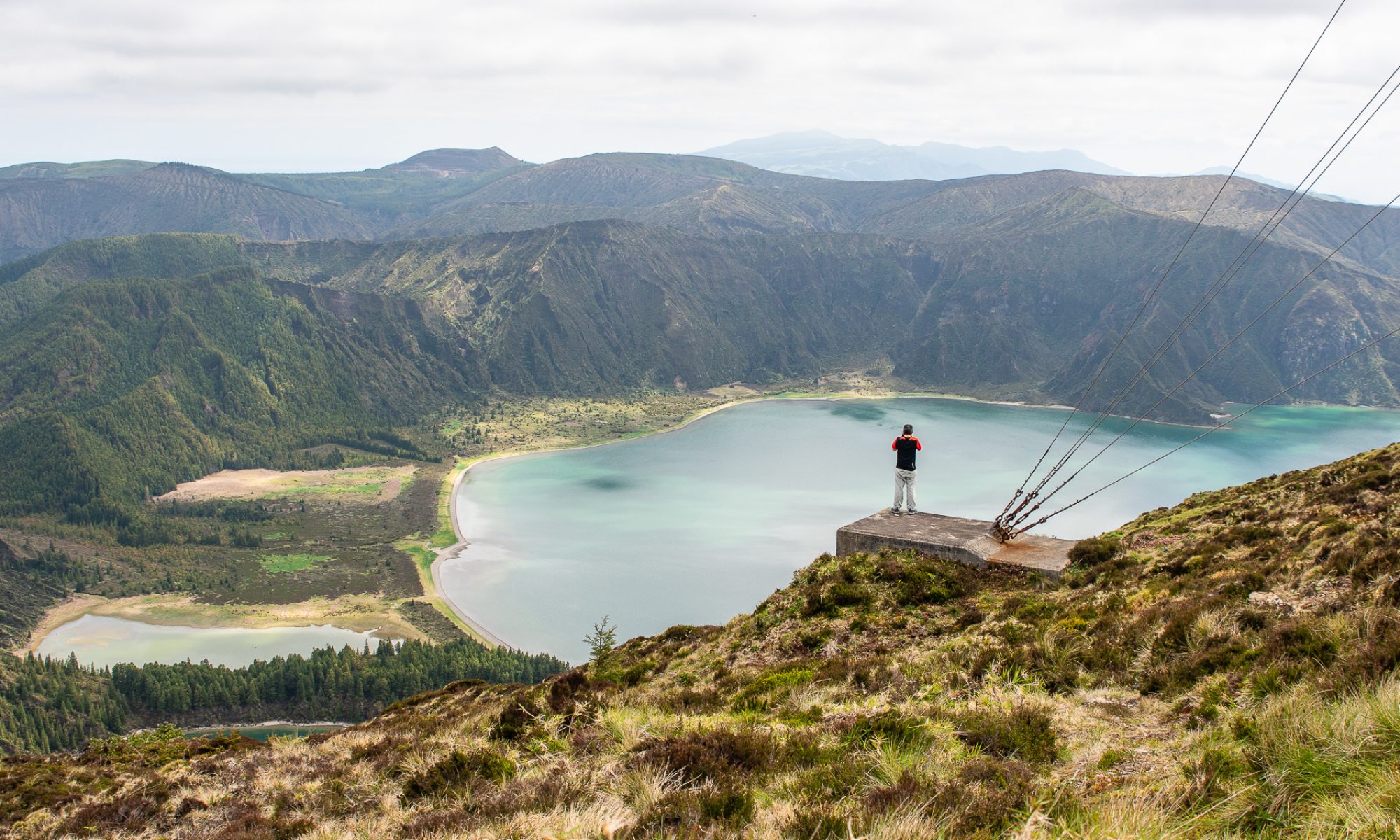
The ultimate filmmaking resource on how to do more with less.







Learn wow to use the subjective power of movement and composition to guide the viewer’s attention and emotions.
SOCIAL
YouTube: 1PersonCrew
Instagram: @1PersonCrew






It doesn’t take a Hollywood budget to make to make the most of available light, and to learn simple tricks to reveal or obscure objects and subjects in your scene. Here’s your chance to learn field tested techniques to manipulate moods, add depth, and enhance your overall production with a few lighting tweaks.
https://www.linkedin.com/learning/lighting-design-for-video-productions/welcome
SOCIAL
YouTube: 1PersonCrew
Instagram: @1PersonCrew
When it comes to video length, a challenge is the tendency to equate “shorter with worse” simply because viewers aren’t used to ultra-short content (like 6-second videos) just yet. But that’s about to change, as lot of big brands with deep pockets have been exploring “six-second ads” including YouTube’s own marketing team.
According to YouTube’s marketing team “the key to success is to view the six-second time frame as a blank canvas rather than a limitation.” I like the sound of that.
All of the examples shown below have been produced for large corporations, with large budgets and most likely big crews. But the reason I believe this is relevant to small-crew and 1 -Person crew productions is because the applications are the same. Short-form videos may be a condensed version of longer stories, or they might be customized to reach specific audiences, for example YouTube vs. Instagram vs, LinkedIn.
Cool? Let’s move on. Other great examples are the Duracell bumper ad, the sequential story for Xbox, or the product lineup for La Mer.
I believe the most interesting examples happen when brands approach the six-second ads as part of a larger campaign—when storytelling expands beyond the boundaries of one ad unit and spans multiple ads served to the same viewer over time. For instance, KFC used a six-second add to tease an UPCOMING 30-second commercial.
Conversely, Danone used the six-second video as a way to echo something a viewer had already seen in a PREVIOUS video.
Similar campaigns by Estée Lauder, and SurveyMonkey are also meaty and memorable. According to SurveyMonkey “the 6-second time constraint was a great driver for creating a sense of energy while communicating the power of the tool simply. This was accomplished by effectively messaging the main components of our platform: creating surveys, collecting answers, and analyzing results.”
As I mentioned earlier, short-form ads an d videos may be a condensed version of a longer story, or they might customized to reach specific audiences through contextual targeting. Campbell’s Soup Company took the latter approach for its “SoupTube” campaign in Australia.
Here’s what Campbell’s did: To amplify a 15-second ad they created hundreds of variations of 6-second ads and ran them as additional media. Using some fancy audience targeting, Campbell’s delivered the contextually relevant 6-second ads to users by matching its product message with trending YouTube videos.
For example, users who searched for Pokémon Go were shown one ad/video where they were asked, “Legs hurt from walking around?”, while users searching the outcome of a specific soccer match saw a different version of the ad asking “Had your money on England?”
By building multiple 6-second stories that offered different facets of its message, Campbell’s proved that short-form ads can provide powerful touches to boost a longer story.
Campbell’s original hypothesis was that the six-second version would “help drive upper funnel metrics like ad recall” and the thirty-second version would “build on that initial impact by telling a longer story to shift perception.” That’s pretty technical, but I get the concept.
What happened with that hypothesis? Glad you asked. The 6-second clips alone were LESS effective than the 30-sec videos to shift brand perception. But, and this is important, when the 6-second clip and 30-sec clip were paired through remarketing (essentially exposing people who had seen the long-form ad to a bumper as a follow-up) the 6-second clips were a great way to reinforce the 30-sec clips.
According to YouTube “the optimal media journey for a viewer is a 30-sec spot followed by another 30-sec spot, followed by a 6-second ad.”
Let’s say you just finished a travel video you would like to promote. It doesn’t hurt (and it doesn’t take that MUCH extra work either) to cut different 30-sec teasers and a few 6-second clips, and try to target specific audiences based on each platform. You could target groups that talk about that specific destination on Facebook, and travel companies on LinkedIn and travel enthusiasts on Instagram. Same travel video, slightly different marketing approaches targeting different people.
What do you think? Leave your comments below.
SOCIAL
YouTube: 1PersonCrew
Instagram: @1PersonCrew
It makes no sense to have a super light laptop and/or camera system and having to carry a heavy bag full of chargers, adapters, and cords.
Also, I’m pretty sure I’m not the only one who has forgotten expensive chargers at hotels (Buenos AIres, Casablanca and Houston) and airports (Porto and Barcelona to name a few), or who has lost a cable that could NOT be replaced (try finding USB-C cables in Myanmar).
And what about spending 14 hours shooting on location, getting late at night to your hotel to dump the day’s footage, and not being able to go to bed because you have to make sure all the batteries are fully charged for the following day? It simply sucks.

So my goal was to find a simple way to charge multiple batteries at once, minimize the amount of chargers and cables, and make everything fit into the most compact package. Ah, and also super important, be able to use this setup anywhere in the world.
Let me introduce you to “the Octopus” a gadget I’ve been using (and fine-tuning) for quite a while. Right now I can charge seventeen (17) batteries and/or devices, with a system that weights only 2.12 pounds (or 0.96 kilos). And the best part, I only need ONE international adapter.

Let’s see what I have on my current setup:


Here’s what you’ll need to build a similar “Octopus”:
One last thing. I don’t know why, but sometimes a “brand name” battery costs more than two third-party batteries, sometimes even including the charger! I’ve using Wasabi batteries and Watson batteries for a long time and never noticed a performance difference against the “original” brand. I don’t know about other brands, but Wasabi and Watson work fine.
Check this out, ONE Sony NP-F970 costs $125.99. You can get the same battery under the “Watson” brand for almost half the price, $69.99. But for only $49.99 you can get TWO “Wasabi” batteries, with an adapter, plus a car charger AND a European plug. Wow!



There are SO many camera bags, all claiming to be THE perfect one for your specific needs. Obviously that’s impossible. So which camera bags are best for the 1 Person Crew and why?
I’ve owned dozens of camera bags in the past 20 years. I actually used to work at a camera store so I was able to field test ANY bag I wanted for a weekend, and then buy it with a significant discount. Needless to say I ended up with a closet full of them, from very uncomfortable “Sling bags” to extra heavy “hard cases” to even a “floating backpack” that I used once….
Over the years I’ve been increasingly demanding when it comes to buying equipment, and this includes camera bags.
I’m always looking for three things: I want the bag to be comfortable, to have the right features (like compartments that are easy to reach for me, but not for pickpockets), and “the look.” I want something that looks nice, but doesn’t scream “Hey! I have $20,000 right here!”
When it comes to brands, I also have used them all. I want a company that keeps innovating and taking risks, that is using high-quality materials, but also offers a fair price, customer service and warranty. This is easier said than done, of course.
At my workshops I often hear attendees complain “$400 for a bag?!?!?! That’s a lot of money!”
But is it? If I’m putting $20,000, $30,000 or even $40,000 inside a bag that will take some serious beating for 5 years, is $400 really a bad investment? I don’t think so.
So, I currently use three kinds of bags, all made by the same company. The smallest bag is a Messenger style bag. That’s the one I use pretty much every day, for my laptop when I’m not shooting, and with a very compact setup, especially if I need very quick access to my camera.

What’s inside that Mesenger Bag? Watch the video below to find out:
The second bag is a video backpack. That’s the one I’m taking with me pretty much every time I leave town. It goes next to me in a taxi, under my seat on a plane, and on my back the rest of the time. That bag NEVER leaves my side.

The third bag is a hybrid bag, which means it’s a rolling case AND a backpack. That’s my carry-on bag, that rolls 90% of the time, and it’s on my back when I’m dealing with sand in Mexico, snow in Chicago, cobblestones in Lisbon, stairs in New York’s subway, and mud in Bali.

So, what about you? Do you have a favorite bag or packing tip? If so, please share your comments below.
DISCLAIMER
This article is not paid or sponsored by anyone. It reflects my own independent opinion. I only recommend companies and products that I trust. Some links might be affiliates, which means I may get a few pennies if you decide to purchase something.
Thanks in advance for your support!
MY VIDEO GEAR
Amazon
ONLINE COURSES
Lynda.com
Mini Tutorials
LinkedIn Learning
SOCIAL
YouTube: 1PersonCrew
Instagram: @1PersonCrew
I have been studying Ira Glass and Anthony Bourdain for a very long time.
Ira Glass is very well known in the U.S. because he is the producer and host of a very well-known radio show called “This American Life.” Bourdain was a celebrity chef, writer, host and producer of travel programs for The Travel Channel and CNN, exploring cultures and foods around the world.

The way the show works is as follows: a team of 12 people go out and find simple stories about everyday topics with normal subjects and characters, and produce fascinating stories about them.
For example, every highway has something called roadkill, which are the dead animals like deer, cats or dogs on the side of the road. Well, someone needs to go and pick them up. So many years ago, Ira Glass produced a story about the person who does that job, and it’s very appropriately called “Dead animal man.”
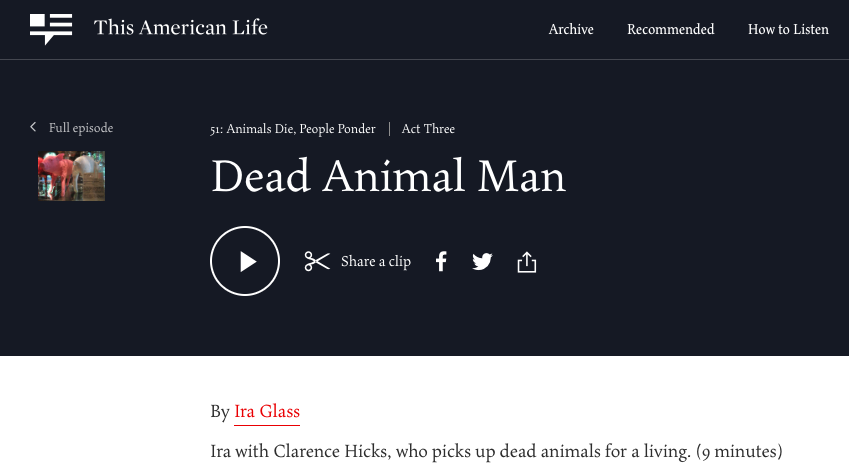
“I’d have given half my life for that squirrel at one time. I was a prisoner during the Korean War and I’d set up off at Han River and watch seagulls fly over, I’ll be laying there thinking I fry one. That’s how hungry I was.”
Clarence Hicks
The way Ira Glass asks and sequences the questions, and the kind of sounds he includes are all masterfully executed.
Ira Glass and his team approach pre-production in a similar way. Every Monday morning a group of 12 people meet, and each person pitches at least one story idea. As a group they pick and choose the best six ideas, and spend the rest of the week producing them. The following Monday they go over the six stories, pick the best one or two, and only those are the ones that get broadcasted. The other stories either die or get a second chance in the future.
The stories we hear on “This American Life” are incredibly good, not only because all the team members are super talented and work extremely hard, but also because they start with 12 stories, narrow them down to six and then hand-picked the best two.
Bourdain stories, on the other hand, were all about traveling to different locations and exploring local food.
“A prego is a steak sandwich slash booze mop that puts you right over the edge in a protein overdose, which is to say, happiness.”
The setup for all Bourdain’s shows was fairly simple. It was always Bourdain with a guest, talking about politics, culture and current events over food.
The way the shows were shot was very efficient. Two cinematographers recording sound on camera, and one director/producer/C Cam operator. Most of the time they used available light.



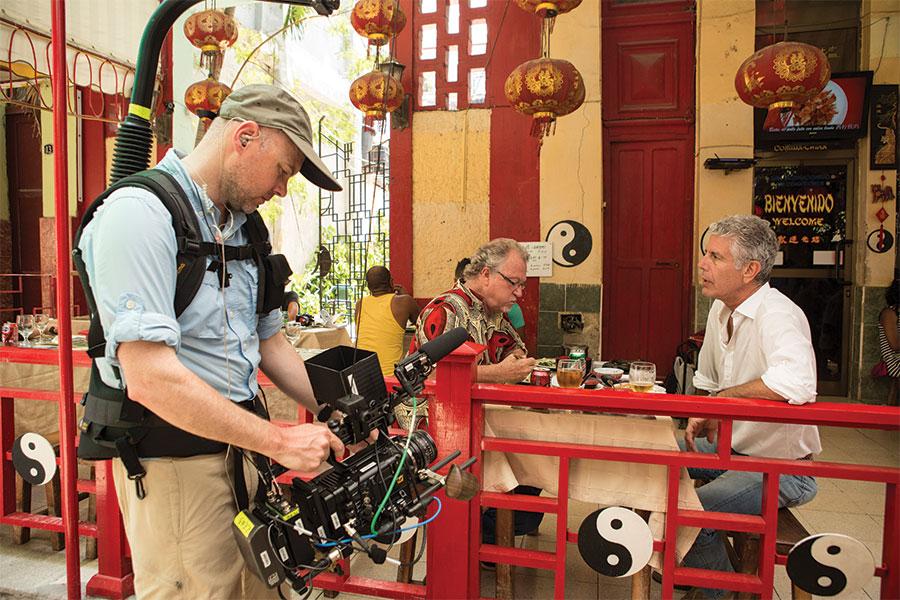
When one watches the show it’s hard to believe they only had a 2 or 3-person crew. And I believe a reason to achieve this high level of production is possible because they started researching each location a month before production, and spent a lot of time in pre-production.
Before each shoot the crew had pre-pro meetings to discuss core concepts, looks, shooting approaches. They found inspiration in movies, songs, books and researched about the history and the place in its current state. Yet, they didn’t use scripts, and Bourdain never wrote anything for a show beforehand.
“If you think you’ve already figured out what the show’s going to be about or what you expect out of the scene, that’s a lethal impulse.”
On location Bourdain and his crew spent on average a week of frantic work, and they shoot a LOT, between sixty and eighty hours of footage (on average) to produce a single one hour-long episode.
Most of us don’t approach our projects the way Glass and Bourdain did. We might have one or two projects or stories, we work on them, and then we might decide to publish them or not, but we don’t produce a high volume of content, and pick only the absolute best of the best to be shared with the world. That constant search for perfection is what makes them so great.
DISCLAIMER
This article is not paid or sponsored by anyone. It reflects my own independent opinion. I only recommend companies and products that I trust. Some links might be affiliates, which means I may get a few pennies if you decide to purchase something.
Thanks in advance for your support!
ONLINE COURSES
Lynda.com
Mini Tutorials
LinkedIn Learning
MY VIDEO GEAR
Amazon
SOCIAL
YouTube: 1PersonCrew
Instagram: @1PersonCrew
DISCLAIMER
This article is not paid or sponsored by anyone. It reflects my own independent opinion. I only recommend companies and products that I trust. Some links might be affiliates, which means I may get a few pennies if you decide to purchase something.
Thanks in advance for your support!
In my previous post I compared 6 different microphones on 6 configurations for filmmakers. Today I will compare 3 different wireless systems, once connected directly to a Panasonic GH5 , and a second time connected to a Zoom H1n field recorder.
The cool thing about these posts is that you will be able to listen to how each mic sounds while recording the same exact audio source, and judge the quality of each system by yourself.


The main goal was to test which mic/system would perform best under real-life situations for people working as a 1 Person Crew, so we chose one of the most popular cameras among indie filmmakers and the most basic field recorder we could find. For these tests I asked the help of Tiago Canadas, a professional audio engineer and owner of Poison Apple Studio, a professional audio facility in Lisbon. He chose a 30 second audio clip of a woman singing, and we meticulously set the mics at exactly the same distance and angle from the speakers.
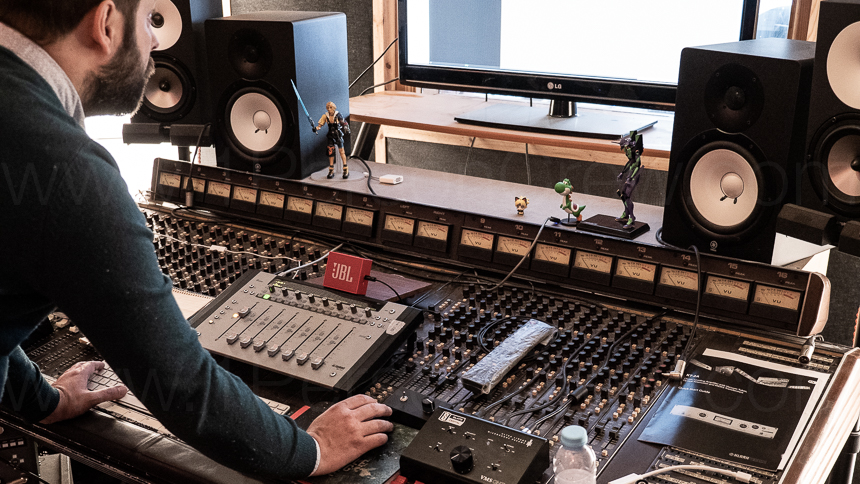
We recorded all the microphones at 48000 Hz Stereo 24 bit, and used the same output settings to export the .wav files from Adobe Premiere Pro.
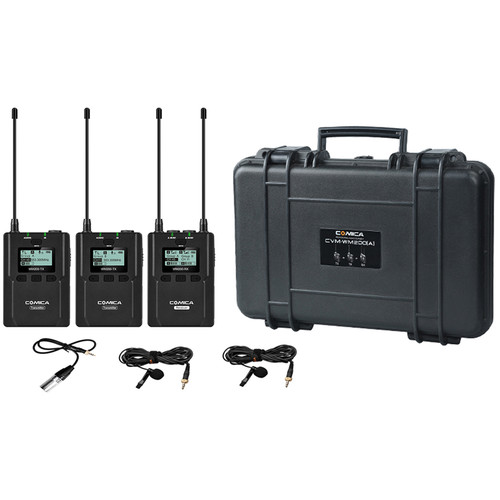
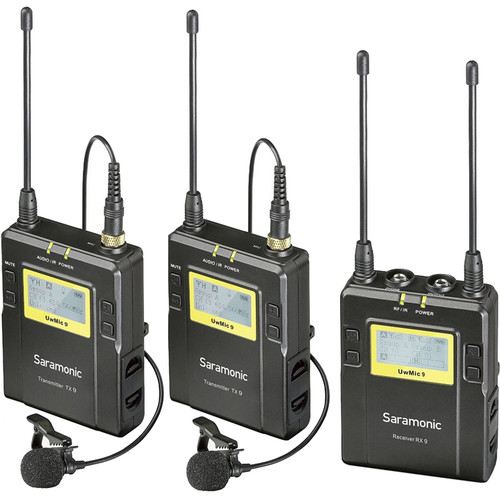
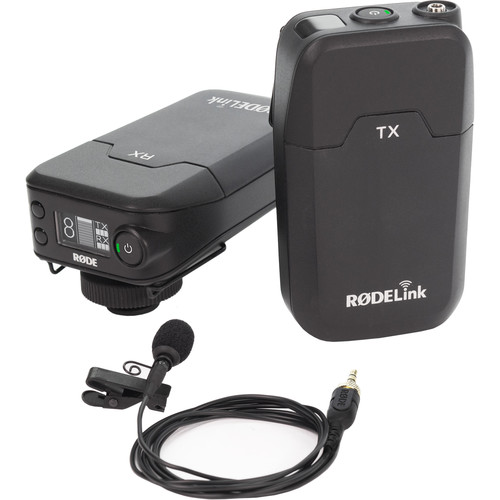
Eduardo’s Comments: The three wireless systems performed very similarly andt he price for the three kits is almost identical. The RodeLink kit recorded more subtle sounds, and the Saramonic a bit less, but overall they seem extremely close.
See Tiago’s Comments at the end of the post.

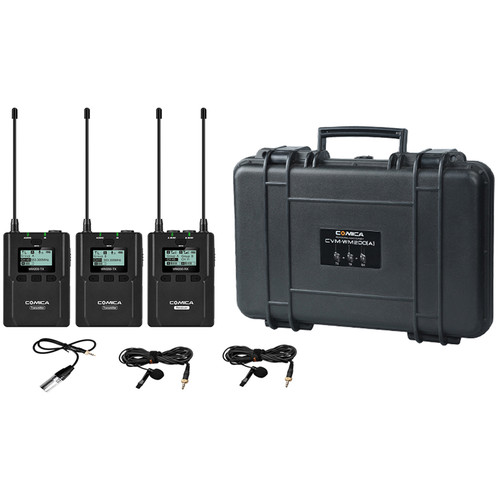
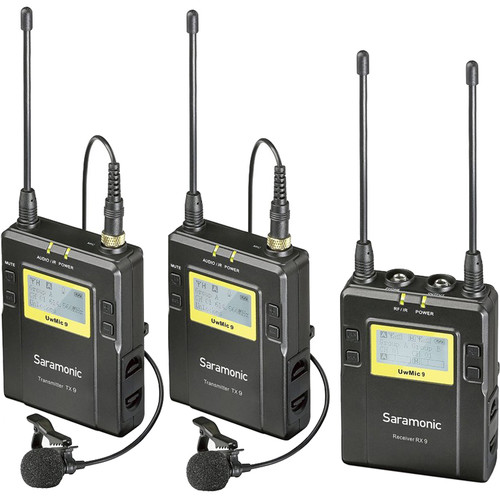
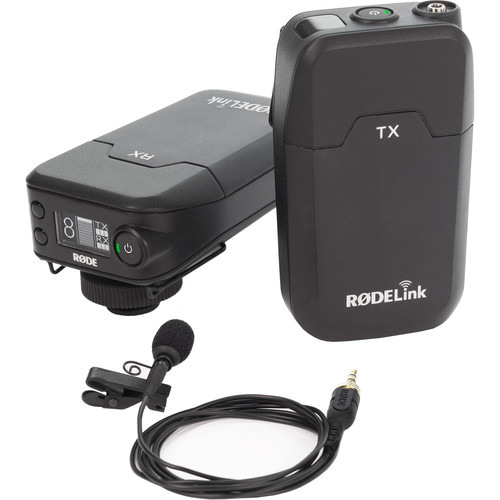
Eduardo’s Comments: The Saramonica and Rode wireless systems are very close, but the Rode seems a bit “crispier. The Comica wireless system captures a less details than the other two.
See Tiago’s Comments at the end of the post.

Tiago’s Comments: The sound from all mics is poor, but this wasn’t a fair test for any of the mics. We should redo the test, adjusting each mic to perform its best and record actual human voices, not a recording.
So here’s a question for you (the reader): If we redo this test, how would YOU like us to test these mics? Write your comments below, send me an email or even a Tweet.
MY VIDEO GEAR
Amazon
ONLINE COURSES
Lynda.com
Mini Tutorials
LinkedIn Learning
SOCIAL
YouTube: 1PersonCrew
Instagram: @1PersonCrew
DISCLAIMER
This article is not paid or sponsored by anyone. It reflects my own independent opinion. I only recommend companies and products that I trust. Some links might be affiliates, which means I may get a few pennies if you decide to purchase something.
Thanks in advance for your support!
In this post I compare 6 different microphones for filmmakers. On the next post I will compare 3 different wireless systems on 2 different configurations each. On both posts you will see the exact gear we used for the tests, and you will be able to listen to how each mic sounds while recording the same exact audio source. Sounds good? Let’s go!
I strongly believe sound is the most important element on a film. We can have the most amazing story, stunning visuals and masterful editing and transitions, but add crappy sound and the viewer will tune out immediately.
For a number of reasons I own different audio sets, but never actually took the time to test them side by side. Until now. A few days ago I called my incredibly talented friend Tiago Canadas who owns Poison Apple Studios, a professional recording studio in Lisbon.
“Poison Apple Studios is a modern recording facility for today´s musician, band, producer, equipped with some of the most cutting-edge and old-school gear within an environment that is dedicated to one thing: creating great music. “

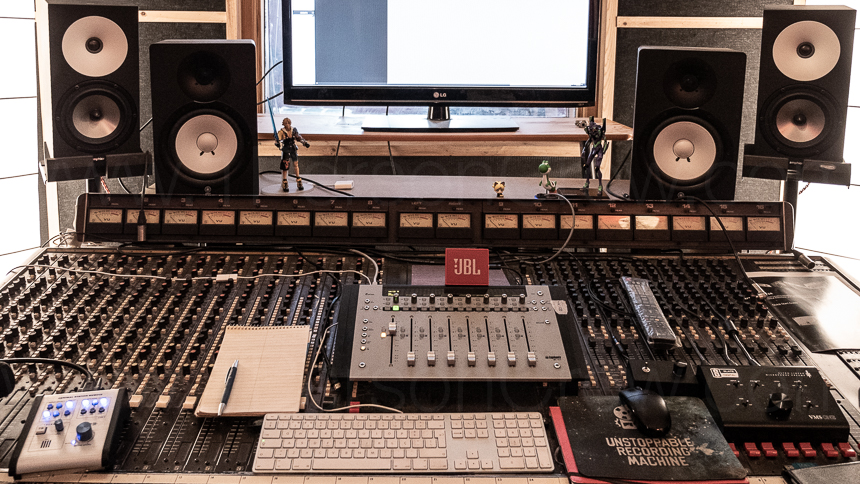
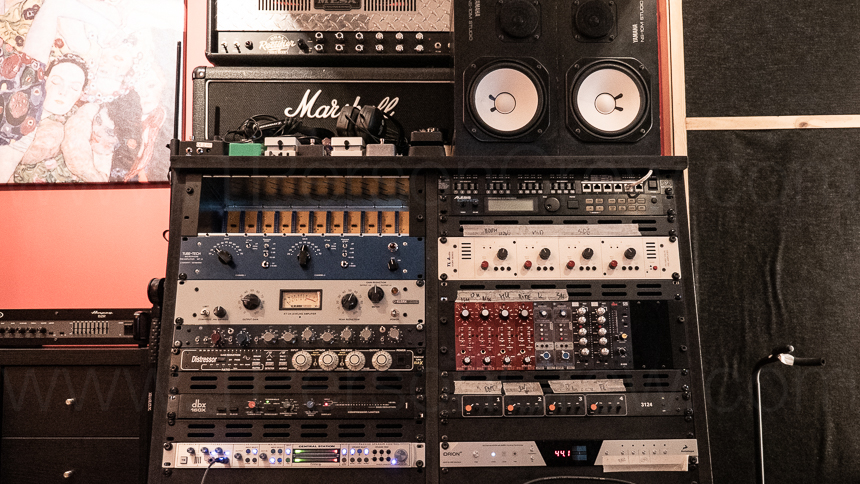
I often joke about how many people spend all their money on a camera, get the kit (aka shitty) lens that comes with it, and if there’s any money left they buy the crappiest tripod in the world. It should be the opposite, as a good solid tripod can last 20 years, a great lens at least 5 to 10 years, and the cameras are being replaced by cheaper, better, faster alternatives every 18 months or less. Well, the same goes with audio gear. You can have a great field recorder and a professional mic, add a low-quality XLR cable and you get low-quality sound.
I’ve set a few professional goals regarding sound for 2019; pay more attention to audio recording while on location, add more sound effects to my projects, get better at choosing the music that enhances the story, and get a better technical understanding of mixing and mastering.
We spent an afternoon designing a test to compare three XLR shotgun mics, three on-camera shotgun mics, three wireless systems connected to a camera, and the same three wireless systems connected to a field recorder.
At some point we considered plugging the mics to Pro Tools and go nuts analyzing the different tracks. But the main goal was to test which mic/system would perform best under real-life situations for people working as a 1 Person Crew, so we chose one of the most popular cameras among indie filmmakers and the most basic field recorder we could find. Tiago chose a 30 second audio clip of a woman singing, and we meticulously set the mics at exactly the same distance and angle from the speakers.

We recorded all the microphones at 48000 Hz Stereo 24 bit, and used the same output settings to export the .wav files from Adobe Premiere Pro.
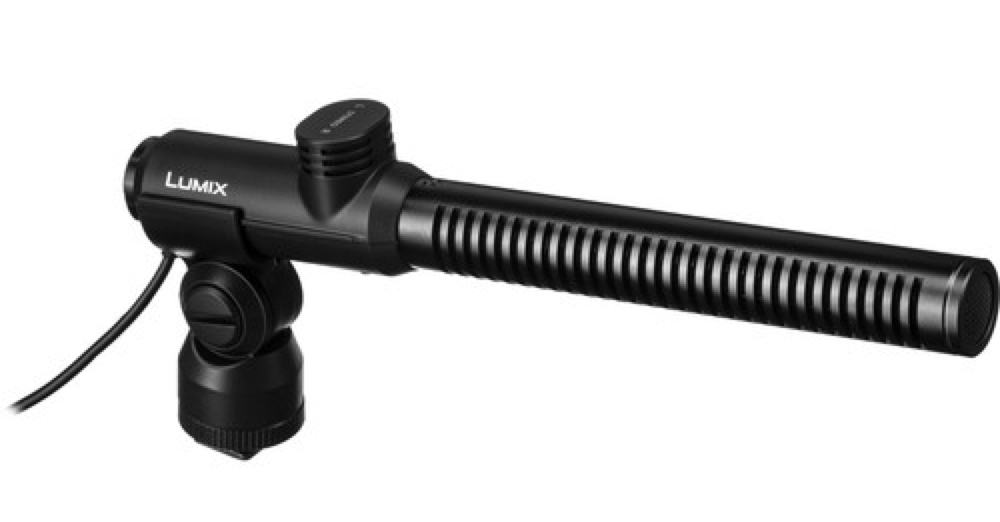


Eduardo’s Comments: Saramonic mini shotgun is as good as the rode video mic go that I’ve used for many many years. The Panasonic shotgun picks up a lot more ambient sound than the other two shotgun mics. The Saramonic Vmic Mini and Rode VideoMic GO seem even in quality (and price).
See Tiago’s Comments at the end of the post.

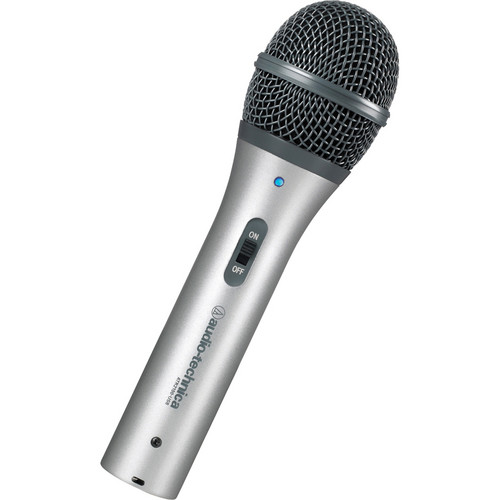
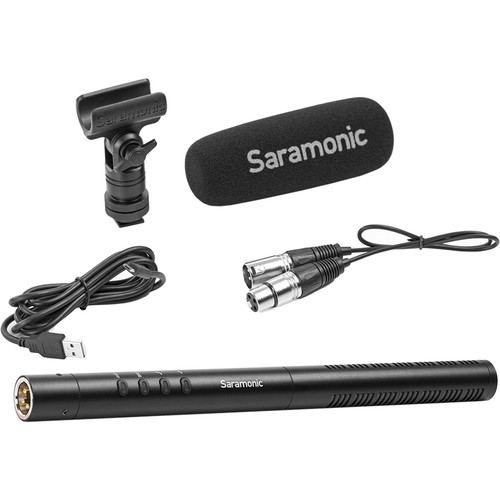
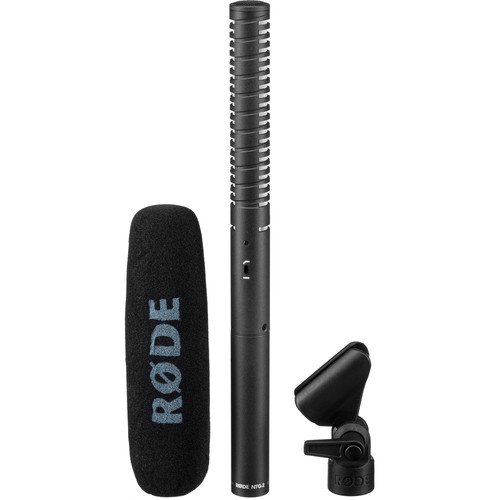


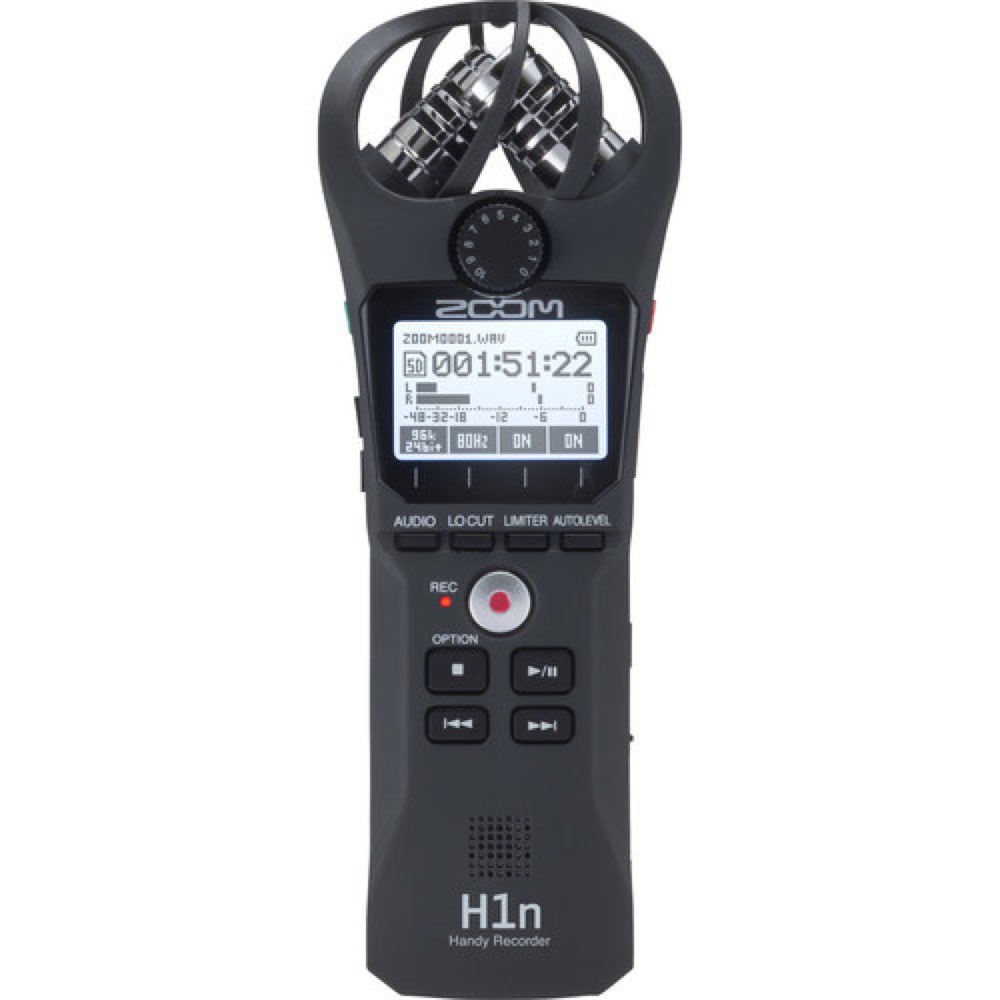
Eduardo’s Comments: This was not a fair competition for the Audio-Technica, as it is a completely different type of mic. The Rode NTG2 has a crisper sound than the Saramonic Shotgun. To me the Rode NTG2 performed better on this test..
See Tiago’s Comments at the end of the post.

Tiago’s Comments: The sound from all mics is poor, but this wasn’t a fair test for any of the mics. We should redo the test, adjusting each mic to perform its best and record actual human voices, not a recording.
On the next post I’ll share the second part of these test, using three different wireless mic kits (with the same set up) on two different recording devices.
So here’s a question for you (the reader): If we redo this test, how would YOU like us to test these mics? Write your comments below, send me an email or even a Tweet.
MY VIDEO GEAR
Amazon
ONLINE COURSES
Lynda.com
Mini Tutorials
LinkedIn Learning
SOCIAL
YouTube: 1PersonCrew
Instagram: @1PersonCrew
Most nights I feel like I’m eating at a Michelin-rated restaurant.
During the past year, my wife has been testing new recipes and the results are both stunningly beautiful and delicious.
This got me thinking on how similar two seemingly different crafts, cooking and filmmaking, really are.
Sometimes tackling a complete video production as a 1 Person Crew feels like running a restaurant by yourself. Possible, but borderline insane.
But the key question you should be asking yourself is “WHY am I doing this?”
If you have a restaurant serving multiple “sittings” each night, and striving to offer safe food, prompt service and an overall good customer experience, you most likely need a team of people working with you. Most likely you’ll also have a huge overhead and anxious investors expecting to see great reviews and even greater profits.
But what if your goal isn’t running a restaurant, but to improve your cooking skills, eat healthier, prepare dishes that are hard to get by where you live and/or simply have a relaxing time with your family or friends? Then you don’t need a commercial kitchen or a team to cook. You can do this alone.
I truly enjoy working “lean and mean” on short projects, learn as much as possible, and apply those new skills to the next project.
Working as a 1 Person Crew offers several advantages, including more intimate conversations with your subjects, the ability to work extremely fast, and forcing you to prepare well in advance, as more often than not, there are no opportunities for retakes (or blaming anybody else for the screw ups!).
Seeing how much time and effort it takes my wife to prepare even a simple meal that will be consumed in a short period of time is mind-blowing. And that’s not including cleaning the mess afterwards!
My wife needs time to find the right recipe and buy fresh, seasonal ingredients at a fair price.
I need time to write the script and shot list, determine a “look and feel” for the project, and test my gear.
She needs enough time to marinate the dish and to actually enjoy the prepping time.
(Lounge music and wine work great, by the way).
I need to allocate enough time to scout locations, get permits, props and go over any logistical challenges.
She needs plenty of time to cook, which often requires following many steps in a specific order and having the right temperature and amounts.
I need cameras, lenses, lights, microphones, monopods, and some sort of plan, or recipe, so I have enough footage to work with in post.
MY VIDEO GEAR
Amazon
The finished meal is often enjoyed by others within minutes or sometimes even seconds.
After days and days of prepping, location scouting, shooting and editing, and running like a madman, I might have a 2-minute video that most people won’t watch until the end.
So, unless someone is really into cooking or filmmaking, few realize how much time and work is behind each meal or video production.
The funny/sad thing is that, as a cook, you don’t have time to get attached to the finished product. Whether a dish is uneatable or it’s an art piece, you have to start from scratch the next day. Same goes with filmmaking. We can’t spend 10 years making sure our video is “perfect” before getting it out!
The best dishes are the ones tested and improved over time. The only way we can master any technique is to consistently practice and do our best to improve ourselves at every new opportunity.
Salud!
On my last post, I shared where to find information about reliable hard drives and a couple of people asked “How is this applicable to a 1 Person Crew video production?”
Well, if I know that a specific 3TB drive from a certain brand has a 50% failure rate, that’s all I need to know to not even consider getting it, regardless its price or features.
Once I know which brands and sizes are the most reliable, I set up my workflow using three hard drives. On this video tutorial I quickly explain why:
Solid state drives are still very expensive, but they tiny, extremely durable, and they are coming down in price.

On location, I like using cheaper internal solid state drives like these to backup my footage.

How are you setting up your hard drives for video production? Leave your comments below.
ONLINE COURSES
Lynda.com
Mini Tutorials
LinkedIn Learning
MY VIDEO GEAR
Amazon
DISCLAIMER
This article is not paid or sponsored by anyone. It reflects my own independent opinion. I only recommend companies and products that I trust. Some links might be affiliates, which means I may get a few pennies if you decide to purchase something.
Thanks in advance for your support!
SOCIAL
YouTube: 1PersonCrew
Instagram: @1PersonCrew